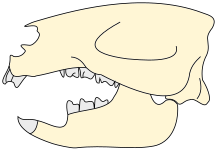Allotheria (meaning "other beasts", from the Greek αλλός, allos–other and θήριον, therion–wild animal) is an extinct clade of mammals known from the Mesozoic and early Cenozoic. Shared characteristics of the group are the presence of lower molariform teeth equipped with longitudinal rows of cusps[1] and enlarged incisors.[2] Typically, the canine teeth are also lost.[2] Allotheria includes Multituberculata, Gondwanatheria (which may be part of Multituberculata, as the sister group to Cimolodonta),[3][4][5][6] and probably Haramiyida,[7] (sometimes only including Euharamiyida[2]) although some studies have recovered haramiyidans to be basal mammaliaforms unrelated to multituberculates.[8] Allotherians are often placed as crown group mammals, more closely related to living marsupials and placentals (Theria) than to monotremesoreutriconodonts,[2] though some studies place the entirety of Allotheria outside of crown Mammalia.[9]
| Allotheria
Possible Late Triassic record | |
|---|---|

| |
| Skull of Ptilodus (Multituberculata) | |

| |
| Skull of Adalatherium (Gondwanatheria) | |
| Scientific classification | |
| Domain: | Eukaryota |
| Kingdom: | Animalia |
| Phylum: | Chordata |
| Class: | Mammalia |
| Clade: | Theriiformes |
| Subclass: | †Allotheria Marsh, 1880 |
| Subgroups | |

Zofia Kielan-Jaworowska, Richard L. Cifelli, and Zhe-Xi Luo, Mammals from the Age of Dinosaurs: Origins, Evolution, and Structure (New York: Columbia University Press, 2004), 249.